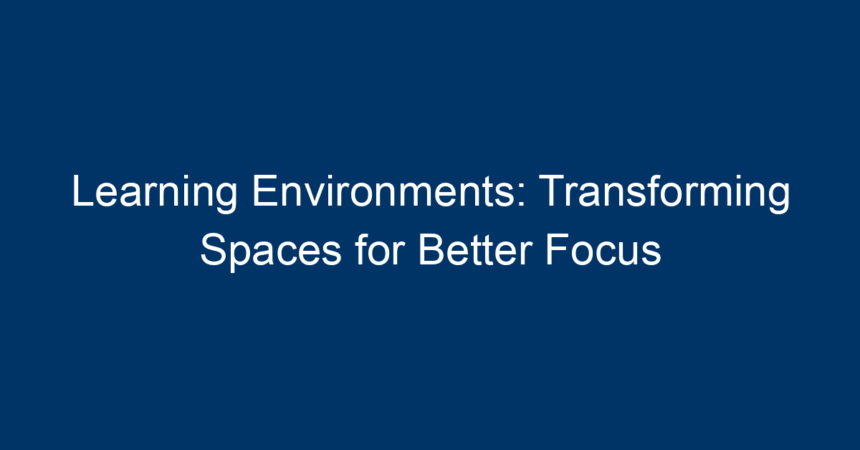In today’s fast-paced world, the spaces where we learn have never been more crucial. As education continues to evolve, the concept of learning environments is at the forefront of discussions about student achievement and well-being. With the right design, these environments can significantly enhance focus, creativity, and overall engagement in both traditional and non-traditional settings. But what exactly makes a learning environment effective, and how can we transform our spaces to better support learning? This article delves into the essential elements of impactful learning environments, their benefits, and actionable strategies for creating spaces that foster better focus.
The Importance of Learning Environments
Understanding Learning Environments
Learning environments encompass all the physical and psychological conditions affecting a learner’s experience. This includes classrooms, libraries, online platforms, study areas, and even outdoor spaces. A well-designed learning environment not only supports educational activities but also promotes mental health, collaboration, and creativity.
The Impact on Focus and Engagement
Recent studies have shown that the design of learning environments can directly affect student performance. Factors such as lighting, furniture arrangement, colors, and ambient noise levels play a significant role in a learner’s ability to concentrate and stay engaged. By understanding these factors, educators and institutions can make informed decisions about how to create environments that encourage better focus and active learning.
Key Elements of an Effective Learning Environment
1. Flexible Layouts
An effective learning space should allow for various configurations to support different activities—be it collaboration, individual work, or group discussions. Flexible layouts, including movable furniture and designated zones, can facilitate different learning styles and preferences. For instance, a mix of individual desks, group tables, and cozy reading corners can cater to varied student needs.
2. Natural Light and Wellbeing
Natural light is a vital component of any learning environment. Studies indicate that exposure to natural light can improve mood, focus, and overall health. Incorporating large windows, skylights, or even outdoor learning spaces can create a more pleasant and stimulating environment. If natural light is limited, consider using full-spectrum lighting to mimic daylight, enhancing learners’ focus and energy levels.
3. Color Psychology
Colors have a profound impact on mood and productivity. Incorporating soothing colors like soft blues and greens can create a calming atmosphere, while vibrant hues like orange and yellow can stimulate creativity and energy. Thoughtful color choices in walls, furniture, and decor can significantly enhance the effectiveness of learning environments.
4. Acoustic Considerations
Noise levels can make or break focus in a learning environment. Implementing sound-absorbing materials, such as carpets, acoustic panels, and curtains, can help reduce distractions. Additionally, creating quiet zones for focused work alongside collaborative spaces allows learners to choose where they want to be based on their immediate needs.
5. Technology Integration
In today’s digital age, technology plays a crucial role in learning environments. Investing in up-to-date, reliable tech resources—such as interactive whiteboards, tablets, and high-speed internet—cultivates an adaptive learning environment. However, it’s essential to balance tech use with traditional learning methods to maintain focus and engagement.
Creating Inclusive Learning Environments
Understanding Diversity in Learning Needs
Every learner has unique strengths and challenges. As we strive to improve learning environments, inclusivity must be a priority. This can mean incorporating assistive technologies, creating spaces for different learning modalities, or offering varied resources to support both advanced learners and those needing additional help.
Collaboration and Community Building
Fostering a sense of community can greatly enhance the learning experience. Providing communal spaces where students can collaborate promotes teamwork and allows learners to share ideas. Creating inclusive group projects or peer-led discussions helps build relationships and enhances understanding of diverse perspectives.
Actionable Insights for Transforming Learning Environments
1. Assess Current Spaces
Begin by evaluating your current learning environments. What works, and what doesn’t? Gather feedback from learners and educators to understand their needs and preferences.
2. Invest in Professional Development
Educators should receive training on creating and maintaining effective learning environments. Workshops or online courses can equip them with strategies to design spaces that promote focus and engagement.
3. Plan for the Future
As education continues to evolve, keep an eye on future trends. Flexible furniture, outdoor learning spaces, and advanced technology are becoming essential in modern learning environments. Incorporate these elements as budgets allow.
4. Foster a Feedback Loop
Encourage ongoing feedback from learners and educators about the learning environment. This dialogue will help maintain a dynamic space that adapts to changing needs and preferences.
5. Promote a Growth Mindset
Encourage learners to take ownership of their surroundings. When students feel invested in the learning environment, they tend to be more engaged and focused. This could mean involving them in the redesign of spaces or creating initiatives that enhance the space through art or planting.
Conclusion
Transforming learning environments is an ongoing process that holds significant potential for improving focus, engagement, and overall educational outcomes. By considering elements like flexible layouts, lighting, color psychology, acoustic design, and technology integration, educators can create spaces that meet the diverse needs of all learners. The journey toward better learning environments is not just about physical changes; it requires a shift in mindset towards inclusivity, collaboration, and continuous improvement.
The quest for effective learning environments is not just an educational imperative; it is a pathway to fostering well-rounded, engaged citizens ready to face an ever-changing world. By implementing the strategies discussed, you will not only enhance focus but also create spaces that inspire creativity and collaboration, ensuring learners thrive today and in the future.




